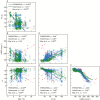Climate as a driver of adaptive variations in ecological strategies in Arabidopsis thaliana
- PMID: 30256896
- PMCID: PMC6266113
- DOI: 10.1093/aob/mcy165
Climate as a driver of adaptive variations in ecological strategies in Arabidopsis thaliana
Abstract
Background and aims: The CSR classification categorizes plants as stress tolerators (S), ruderals (R) and competitors (C). Initially proposed as a general framework to describe ecological strategies across species, this scheme has recently been used to investigate the variation of strategies within species. For instance, ample variation along the S-R axis was found in Arabidopsis thaliana, with stress-tolerator accessions predominating in hot and dry regions, which was interpreted as a sign of functional adaptation to climate within the species.
Methods: In this study the range of CSR strategies within A. thaliana was evaluated across 426 accessions originating from North Africa to Scandinavia. A position in the CSR strategy space was allocated for every accession based on three functional traits: leaf area, leaf dry matter content (LDMC) and specific leaf area (SLA). Results were related to climate at origin and compared with a previous study performed on the same species. Furthermore, the role of natural selection in phenotypic differentiation between lineages was investigated with QST-FST comparisons, using the large amount of genetic information available for this species.
Key results: Substantial variation in ecological strategies along the S-R axis was found in A. thaliana. By contrast with previous findings, stress-tolerator accessions predominated in cold climates, notably Scandinavia, where late flowering was associated with traits related to resource conservation, such as high LDMC and low SLA. Because of trait plasticity, variations in CSR classification in relation to growth conditions were also observed for the same genotypes.
Conclusions: There is a latitudinal gradient of ecological strategies in A. thaliana as a result of within-species adaptation to climate. Our study also underlines the importance of growth conditions and of the methodology used for trait measurement, notably age versus stage measurement, to infer the strength and direction of trait-environment relationships. This highlights the potential and limitations of the CSR classification in explaining functional adaptation to the environment.
Figures




References
-
- Aguirrezábal LAN, Bouchier-Combaud S, Radziejwoski A, Dauzat M, Cookson SJ, Granier C.. 2006. Plasticity to soil water deficit in Arabidopsis thaliana: dissection of leaf development into underlying growth dynamic and cellular variables reveals invisible phenotypes. Plant, Cell & Environment 29: 2215–2227. - PubMed
-
- Albert CH, Thuiller W, Yoccoz NG, et al. . 2010. Intraspecific functional variability: extent, structure and sources of variation. Journal of Ecology 98: 604–613.
-
- Albert CH, Grassein F, Schurr FM, Vieilledent G, Violle C.. 2011. When and how should intraspecific variability be considered in trait-based plant ecology?Perspectives in Plant Ecology, Evolution and Systematics 13: 217–225.
-
- Anderegg LDL, Berner LT, Badgley G, Sethi ML, Law BE, HilleRisLambers J.. 2018. Within-species patterns challenge our understanding of the leaf economics spectrum. Ecology Letters 21: 734–744. - PubMed
Publication types
MeSH terms
LinkOut - more resources
Full Text Sources
Other Literature Sources
Research Materials
Miscellaneous

